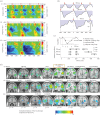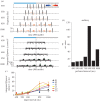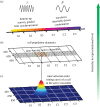Finding the beat: a neural perspective across humans and non-human primates
- PMID: 25646516
- PMCID: PMC4321134
- DOI: 10.1098/rstb.2014.0093
Finding the beat: a neural perspective across humans and non-human primates
Abstract
Humans possess an ability to perceive and synchronize movements to the beat in music ('beat perception and synchronization'), and recent neuroscientific data have offered new insights into this beat-finding capacity at multiple neural levels. Here, we review and compare behavioural and neural data on temporal and sequential processing during beat perception and entrainment tasks in macaques (including direct neural recording and local field potential (LFP)) and humans (including fMRI, EEG and MEG). These abilities rest upon a distributed set of circuits that include the motor cortico-basal-ganglia-thalamo-cortical (mCBGT) circuit, where the supplementary motor cortex (SMA) and the putamen are critical cortical and subcortical nodes, respectively. In addition, a cortical loop between motor and auditory areas, connected through delta and beta oscillatory activity, is deeply involved in these behaviours, with motor regions providing the predictive timing needed for the perception of, and entrainment to, musical rhythms. The neural discharge rate and the LFP oscillatory activity in the gamma- and beta-bands in the putamen and SMA of monkeys are tuned to the duration of intervals produced during a beat synchronization-continuation task (SCT). Hence, the tempo during beat synchronization is represented by different interval-tuned cells that are activated depending on the produced interval. In addition, cells in these areas are tuned to the serial-order elements of the SCT. Thus, the underpinnings of beat synchronization are intrinsically linked to the dynamics of cell populations tuned for duration and serial order throughout the mCBGT. We suggest that a cross-species comparison of behaviours and the neural circuits supporting them sets the stage for a new generation of neurally grounded computational models for beat perception and synchronization.
Keywords: beat perception; beat synchronization; modelling; neurophysiology.
© 2015 The Author(s) Published by the Royal Society. All rights reserved.
Figures




Similar articles
-
Neural Entrainment to the Beat: The "Missing-Pulse" Phenomenon.J Neurosci. 2017 Jun 28;37(26):6331-6341. doi: 10.1523/JNEUROSCI.2500-16.2017. Epub 2017 May 30. J Neurosci. 2017. PMID: 28559379 Free PMC article.
-
Neural synchronization is strongest to the spectral flux of slow music and depends on familiarity and beat salience.Elife. 2022 Sep 12;11:e75515. doi: 10.7554/eLife.75515. Elife. 2022. PMID: 36094165 Free PMC article.
-
Experimental evidence for synchronization to a musical beat in a nonhuman animal.Curr Biol. 2009 May 26;19(10):827-30. doi: 10.1016/j.cub.2009.03.038. Epub 2009 Apr 30. Curr Biol. 2009. PMID: 19409790
-
The role of the basal ganglia in beat perception: neuroimaging and neuropsychological investigations.Ann N Y Acad Sci. 2009 Jul;1169:35-45. doi: 10.1111/j.1749-6632.2009.04553.x. Ann N Y Acad Sci. 2009. PMID: 19673753 Review.
-
Exploring how musical rhythm entrains brain activity with electroencephalogram frequency-tagging.Philos Trans R Soc Lond B Biol Sci. 2014 Dec 19;369(1658):20130393. doi: 10.1098/rstb.2013.0393. Philos Trans R Soc Lond B Biol Sci. 2014. PMID: 25385771 Free PMC article. Review.
Cited by
-
Without it no music: cognition, biology and evolution of musicality.Philos Trans R Soc Lond B Biol Sci. 2015 Mar 19;370(1664):20140088. doi: 10.1098/rstb.2014.0088. Philos Trans R Soc Lond B Biol Sci. 2015. PMID: 25646511 Free PMC article.
-
Keeping an eye on the conductor: neural correlates of visuo-motor synchronization and musical experience.Front Hum Neurosci. 2015 Apr 2;9:154. doi: 10.3389/fnhum.2015.00154. eCollection 2015. Front Hum Neurosci. 2015. PMID: 25883561 Free PMC article.
-
Evaluation of physiological response and synchronisation errors during synchronous and pseudosynchronous stimulation trials.Sci Rep. 2024 Apr 16;14(1):8814. doi: 10.1038/s41598-024-59477-7. Sci Rep. 2024. PMID: 38627479 Free PMC article.
-
Neural Entrainment to the Beat: The "Missing-Pulse" Phenomenon.J Neurosci. 2017 Jun 28;37(26):6331-6341. doi: 10.1523/JNEUROSCI.2500-16.2017. Epub 2017 May 30. J Neurosci. 2017. PMID: 28559379 Free PMC article.
-
Neural Encoding and Representation of Time for Sensorimotor Control and Learning.J Neurosci. 2021 Feb 3;41(5):866-872. doi: 10.1523/JNEUROSCI.1652-20.2020. Epub 2020 Dec 30. J Neurosci. 2021. PMID: 33380468 Free PMC article. Review.
References
-
- Honing H. 2013. Structure and interpretation of rhythm in music. In Psychology of music (ed. Deutsch D.), 3rd edn, pp. 369–404. London, UK: Academic Press.
-
- Large EW, Palmer C. 2002. Perceiving temporal regularity in music. Cogn. Sci. 26, 1–37. (10.1207/s15516709cog2601_1) - DOI
-
- Large EW, Jones MR. 1999. The dynamics of attending: how people track time-varying events. Psychol. Rev. 106, 119–159. (10.1037/0033-295X.106.1.119) - DOI
Publication types
MeSH terms
Grants and funding
LinkOut - more resources
Full Text Sources
Other Literature Sources
Medical

